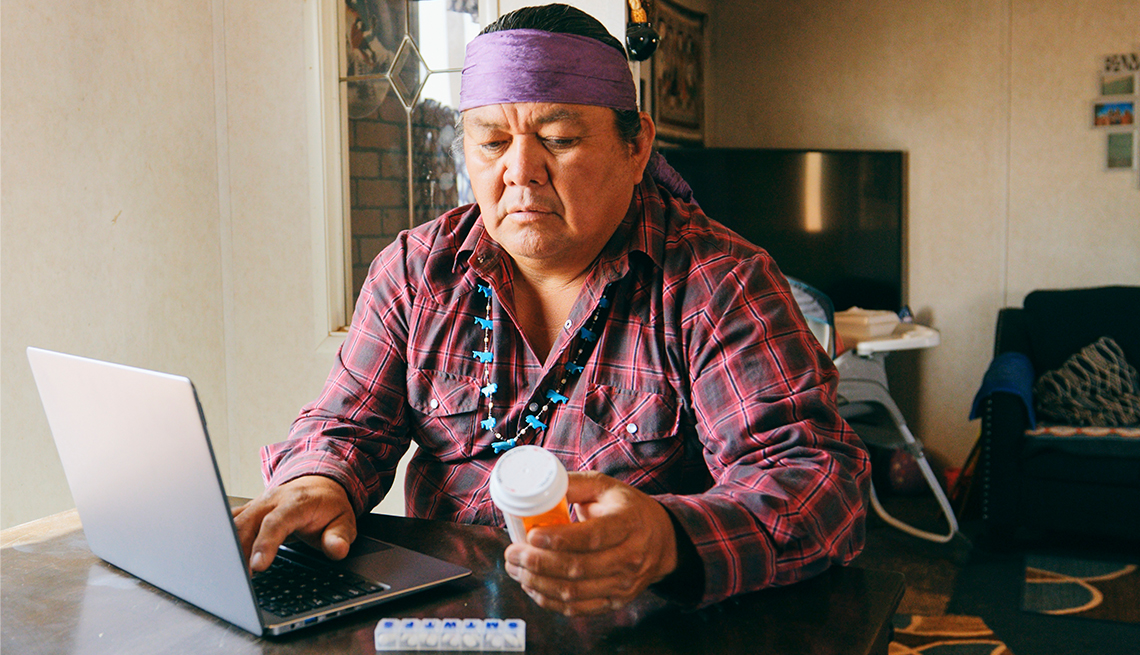AARP Hearing Center
Sorting out the Prescription Drug Assistance Options Available to Native Elders
By James McSpadden, November 13, 2023 04:38 PM

Last fall my aunt called asking for help. Her pharmacist had just told her that in January she would need to pay over $500 to fill a one-month supply of her brand-name blood thinner. Her dilemma, while seemingly straightforward, involved some additional consideration. As an older citizen of the Cherokee Nation, my aunt and I needed to consider not only what prescription assistance is available to older adults, but also the range of prescription assistance available to native elders—members of federally recognized tribes ages 50 and older.[*]
Prescription drug assistance is particularly important to native elders
My aunt is one of over half a million native elders in the U.S. In 2021, this population included over 300,000 adults ages 50 to 64 and over 200,000 adults ages 65 and older; more than one-third (36 percent) lived in three states (Arizona, New Mexico, and Oklahoma).

Source: AARP analysis of the American Community Survey.
Unfortunately, a large number of native elders live with chronic disease. In 2018, ninety percent of native elders had at least one chronic condition—high blood pressure, diabetes, and arthritis are most common—and nearly half (45 percent) had three or more. This high disease burden—born out of historic social and economic disparities (e.g., high rates of poverty and underfunding of health care)—has led to native elders dying, on average, 5.5 years earlier than other older adults.
Additionally, a sizable number of native elders, including my aunt, have limited incomes. The average annual income for a native elder is less than $30,000, and twice as many native elders have incomes below 100 percent of the federal poverty level compared to other older adults.
Prescription drug assistance available to lower-income older adults
Older native adults enrolled in Medicare’s prescription drug program (Part D), like all Part D enrollees, may be eligible for Medicare’s Low-Income Subsidy (LIS). This program helps pay for Medicare Part D monthly premiums, annual deductibles, and out-of-pocket drug costs for Part D enrollees who earn up to 150 percent of the federal poverty level ($21,870 for individuals in 2023) annually. In 2021 some 7,000 native elders were enrolled in LIS—3 percent of all American Indian/Alaska Native Medicare enrollees. Still, nearly 96,000 were eligible but not enrolled, leaving room for greater adoption.
Some native elders with low incomes may also be eligible to enroll in state pharmaceutical assistance programs (SPAPs). Fourteen states operate an SPAP for older adults, each with unique benefits and eligibility criteria. SPAPs provide financial assistance for prescription drug costs such as Medicare Part D premiums or drug copays. Close to 15,000 native elders ages 65 and older may be eligible for one of these SPAPs.[†]
Native elder-specific prescription drug assistance
Native elders may also be eligible for additional resources based on their tribal enrollment. Indian Health Services (IHS) provides direct health care to members of federally recognized tribes through over 687 facilities, both IHS-operated and tribal-operated. Native elders may be able to receive no-cost prescriptions at these facilities, although doing so may require effort. First, a native elder must be able to access care at one of these facilities. Most facilities are located on or near reservations, yet only 44 percent of native elders live on tribal lands, and that percentage is decreasing. Moreover, not all facilities offer pharmacy services and some offer only limited services (e.g., filling prescriptions from certain providers or filling only certain drugs).
A small number of tribes use their owns funds to offer elders direct financial assistance to help offset their out-of-pocket expenses. Each tribe uniquely designs its tribal assistance program and sets benefits and eligibility parameters, much like SPAPs. The Chickasaw Nation Pharmacy Refill Center covers the full prescription costs for Medicare Part D-enrolled citizens of any tribe and their spouses. Meanwhile, prescription assistance through the Cheyenne and Arapaho tribes provides elders of these tribes up to $800 a year for qualifying prescriptions.
Tribes may also offer prescription assistance through the Medicare Part D Tribal Plan Sponsorship Program, which grants discretion to use federal and third-party funding to pay Medicare Part D premiums for eligible native elders. The program also empowers tribes to coordinate premium payments with contracted Part D plans, provide outreach to elders, and assist with enrollment. The Prairie Band Potawatomi Nation, located in northeast Kansas, offers a Sponsorship Program to enrolled elders (and certain spouses and dependents) to improve prescription drug coverage for its elders and reimbursement for the Prairie Band Potawatomi Health Center.
Streamlining prescription drug assistance to native elders
After hours of discussion, my aunt and I identified a tribal assistance program that was available to her, but not all native elders have the resources to make equally informed decisions. Native elders must first sort through the range of federal, state, and tribal options to identify what resources and financial assistance may be available to them. Then they must probe those programs to determine if they qualify based on their income, where they live, tribal enrollment, or other required criteria. Putting together meaningful assistance may be possible, but it may take time, effort, and patience. To ease this burden, states and tribes should look for ways to improve outreach to native elders, simplify and harmonize eligibility determinations, and coordinate enrollment in various assistance programs.
[*] Native elder is a broad term used here to identify older adults ages 50 and older who identify as American Indian or Alaskan Native. Individual tribes may define elders differently or use other titles for older members.
[†] AARP and NORC at the University of Chicago analysis of Annual Social and Economic Supplement (ASEC) data and Medicare’s Medicare Master Beneficiary Summary File (MBSF).
































































